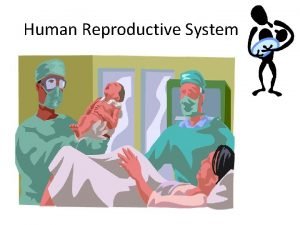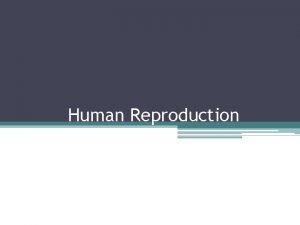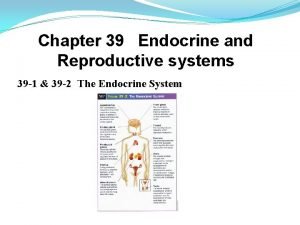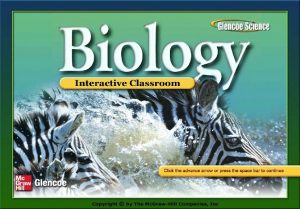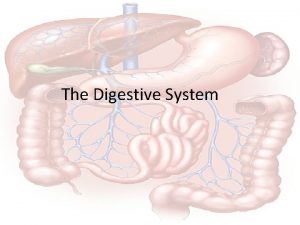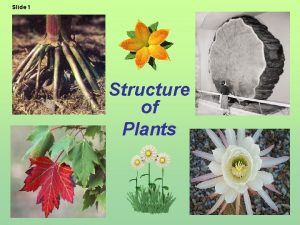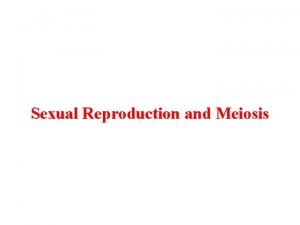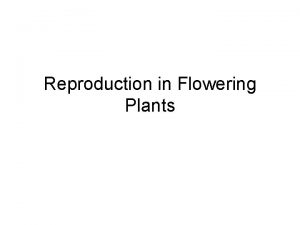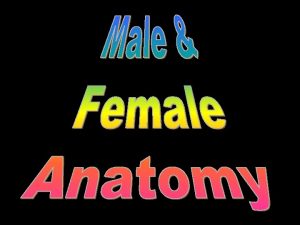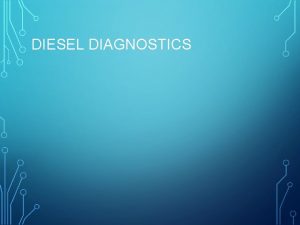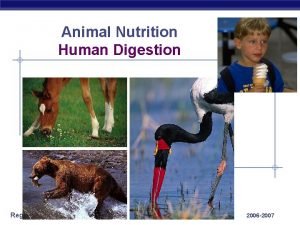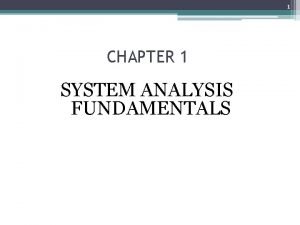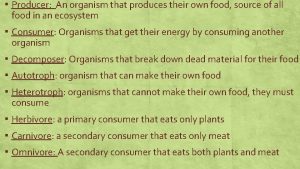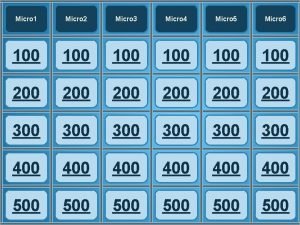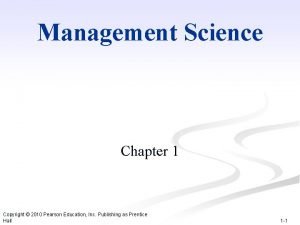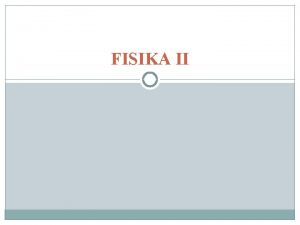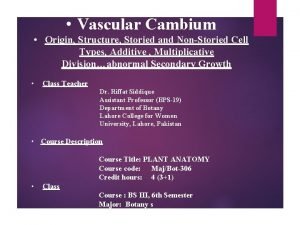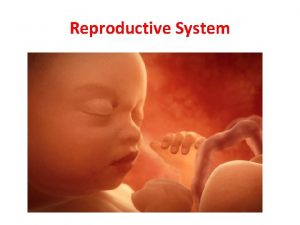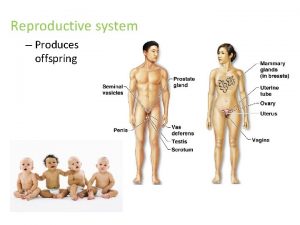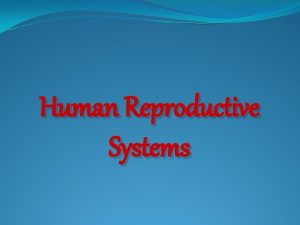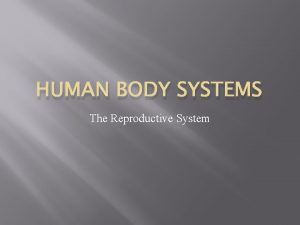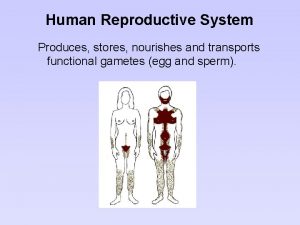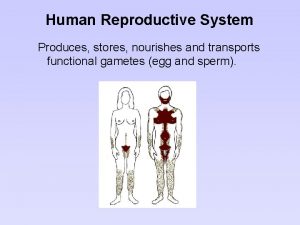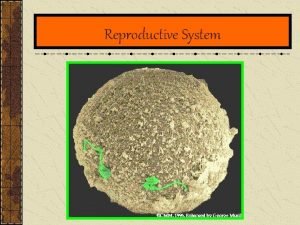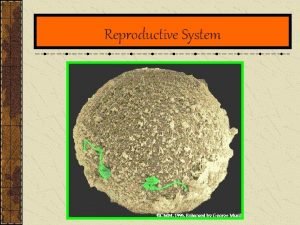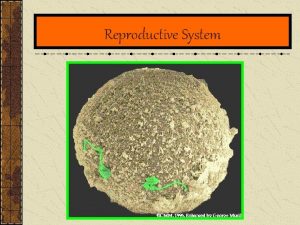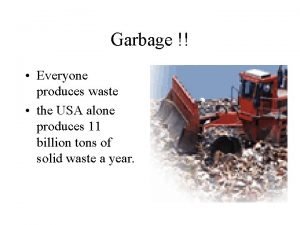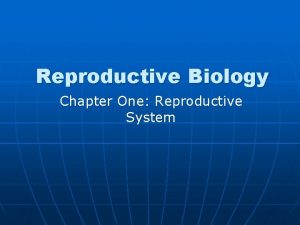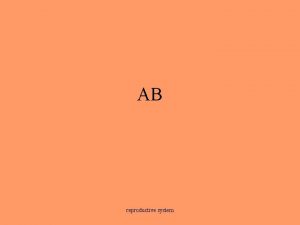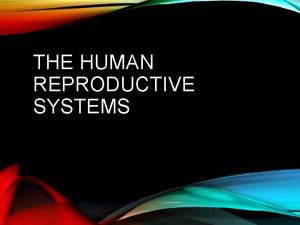Reproductive system Reproductive Systems Human reproductive system Produces
































- Slides: 32

Reproductive system

Reproductive Systems • Human reproductive system – Produces, stores, nourishes and transports functional gametes • Fertilization – Fusion of sperm and immature ovum • Forms zygote

Reproductive System Components • • Gonads Ducts Accessory organs and glands External genitalia

Fig 27. 1 The scrotum is a pouch of skin Inside the scrotum there are two scrotal cavities that each contain a testis Male reproductive system

• Males – Testes produce sperm – Expelled from body in semen during ejaculation • Females • Ovaries produces eggs – Travel along uterine tubes to uterus – Vagina connects uterus with exterior

• • • Sperm produced in testes Travel along epididymus Ductus deferens Ejaculatory duct Urethra Male • Seminal vesicles • Prostate gland • Bulbourethral glands – Secrete into ejaculatory ducts and urethra • Scrotum – Encloses testes • Penis – Erectile organ


Fig 27. 1

Testes • Enclosed in scrotum – 2 inches by 1 inch • Descent of testes through inguinal canals – During 7 th month of development – Prior to descent, held in place by gubernaculum testis • No descent - cryporchidism - sterile

• Diagrammatical sectional view at representative stages of the descent of the testes.

Spermatic Cord • Layers of connective tissue, fascia and muscle • Encloses ductus (vas) deferens, testicular artery, testicular vein and nerves Thermoregulation by muscles in Scrotum • Dartos muscle wrinkles skin of scrotum • Cremaster muscle pulls testes closer to body


Seminiferous tubules • Site of sperm production – Sperm move to straight tubule – On to rete testis • Efferent ducts connect rete testis to epididymus • Interstitial cells – Between seminiferous tubules – Secrete androgens

Fig 27. 7 Sperm is produced in the seminiferous tubules of the testis


Histology of the Testes • Tunica vaginalis serous membrane cover • Tunica albuginea fibrous capsule that surrounds testis



Anatomy of Sperm • Head – Acrosomal cap • Neck • Middle piece • Tail – Flagellum

Teste Histology

Epididymus receives spermatozoa from testes Head, body and tail regions of epididymus Monitors and adjusts composition of tubular fluid Recycles damaged spermatozoa Stores spermatozoa Capacitation

Vas or Ductus Deferens • Begins at epididymus • Passes through inguinal canal • Enlarges near prostate to ampulla – Junction at base of seminal vesicle and ampulla • Ejaculatory duct • Empties to urethra • Transports and stores spermatozoa

Male Urethra Urinary bladder through penis • Three regions – Prostatic urethra – Membranous urethra – Penile urethra

Accessory Glands • Activate and provide nutrients to spermatozoa • Produce buffers to neutralize acidity of female tract • Include – Seminal vesicle – Prostate gland – Bulbourethral glands Semen • • Typical ejaculation releases 2 -5 ml Sperm count typically 20 – 100 million per ml Seminal fluid is mixture of accessory gland secretions Contains enzymes

Seminal Vesicles • Paired gland • 60% semen volume • Secretion high in fructose – Produces ATP for spermatozoa – Spermatozoa become active after contact with seminal fluids

Prostate Gland • • • Secretes prostatic fluid 20 -30% semen volume Prostaglandins Alkaline buffer prostate specific antigen (PSA)

Bulbourethral Gland • Paired glands • Alkaline mucus secretion • Lubricating properties

Penis • Root, body (shaft) and glans • Prepuce (foreskin) surrounds tip • • Three masses of erectile tissue – Two corpora cavernosa – One corpus spongiosum • Surrounds urethra Erection governed by smooth muscles in arterial walls – Erectile tissues become engorged with blood

Fig 27. 9

• Frontal and cross sections showing the structures of the penis.


penis Corpora caveronsa Corpus spongiosum urethra
 Where is the sperm located
Where is the sperm located Identify the structure
Identify the structure What human activity produces the most greenhouse gases
What human activity produces the most greenhouse gases Male plant reproductive system
Male plant reproductive system Fertilization occurs
Fertilization occurs Human reproductive system
Human reproductive system Section 39-4 fertilization and development
Section 39-4 fertilization and development Ovulation animation
Ovulation animation Chapter 2 human reproductive anatomy and physiology
Chapter 2 human reproductive anatomy and physiology Female anatomy labeled
Female anatomy labeled Endocrine system and reproductive system
Endocrine system and reproductive system What produces bile
What produces bile A reflecting telescope produces an image using a(n) ____.
A reflecting telescope produces an image using a(n) ____. Sound travels fastest through
Sound travels fastest through Structure of the stamen and pollen
Structure of the stamen and pollen Produces diploid cells
Produces diploid cells What part of the plant produces pollen
What part of the plant produces pollen Produces testosterone
Produces testosterone What produces thrombopoietin
What produces thrombopoietin Flower
Flower The three phases of diesel ignition include
The three phases of diesel ignition include An error in reasoning that produces a flawed argument
An error in reasoning that produces a flawed argument What produces bile
What produces bile What produces bile
What produces bile Assume that a firm produces output using one fixed input
Assume that a firm produces output using one fixed input A set of related components that produces specific results
A set of related components that produces specific results An organism that produces its own food
An organism that produces its own food A farmer produces peppers in a perfectly competitive market
A farmer produces peppers in a perfectly competitive market The willow furniture company produces tables
The willow furniture company produces tables Hambatan pengganti
Hambatan pengganti Xylem and phloem diagram
Xylem and phloem diagram A zoom lens produces an inverted real image
A zoom lens produces an inverted real image Neurulation
Neurulation




